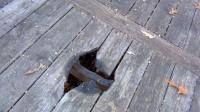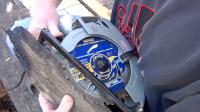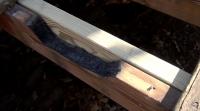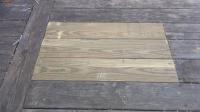How to repair a deck
If you have ever had a rotten board in your deck or a rotten tenant that made a hole in your deck you know how costly it can be to have a carpenter come and fix it. I will show you how with a few common tools you can repair the hole in the deck yourself and save money.
Items used
Circular Saw (used from eBay)
circular saw (new from Amazon)
Wood chisels
screwdriver
deck screws
tape measure
Click on photos for larger version.
For this howto we will repair a deck damaged by a tenant using a fire pit on the deck. Not only is there damage to the deck floor boards but the joist below is also damaged. We will repair both of these issues.
 Hole in deck: Hole in deck caused by tenant using fire pit on a wooden deck.
Hole in deck: Hole in deck caused by tenant using fire pit on a wooden deck.
First of all find the location of the joists so you can cut the damaged deck boards out back to a spot where you can still screw the new board into the joist.
Usually there are already screws or nails in a row going down the joist so you can find it that way or there are gaps between the deck boards and you can see the joists.
 Set blade depth: Set the depth of your saw so you just barely cut through the board so you don't damage the joists below.You want to cut out the deck boards but not cut into the joists so set the depth of your circular saw to just a little deeper than the height of the deck board. You can either use a tape measure or set your saw down on the edge of a board and to set the correct depth.
Set blade depth: Set the depth of your saw so you just barely cut through the board so you don't damage the joists below.You want to cut out the deck boards but not cut into the joists so set the depth of your circular saw to just a little deeper than the height of the deck board. You can either use a tape measure or set your saw down on the edge of a board and to set the correct depth.
You will want to cut the deck boards down the middle of the joist so both the new board and then remaining piece of the old deck board are supported.
 Cutting out damaged board: Cut down the middle of the joist to remove the damaged section of the board.Make sure when cutting not to go too far and cut into undamaged boards. The circular saw won't be able to cut clear to the edge of the deck board but you can finish off the cut with a wood chisel.
Cutting out damaged board: Cut down the middle of the joist to remove the damaged section of the board.Make sure when cutting not to go too far and cut into undamaged boards. The circular saw won't be able to cut clear to the edge of the deck board but you can finish off the cut with a wood chisel.
Now measure the length of the piece you need to replace and head to the lumber yard to get a replacement board. We also have a damaged joist so we will get a board to fix that as well.
 Sistered Board: We sistered on a new board to help carry the weight of the deck across the damaged area.The next step is to sister on a new floor joist. This just means to attache to the side of the current joist another board to help carry the load across the damaged area of the joist. Usually this sistered board is the same size as the damaged board and long enough to attach and spread out the load. You may have to use a sister board that is the same length as the original board.
Sistered Board: We sistered on a new board to help carry the weight of the deck across the damaged area.The next step is to sister on a new floor joist. This just means to attache to the side of the current joist another board to help carry the load across the damaged area of the joist. Usually this sistered board is the same size as the damaged board and long enough to attach and spread out the load. You may have to use a sister board that is the same length as the original board.
We started out by starting the screws in to the new board so we didn't have to hold the board up the whole time we were putting in the screws. We also used a drill with a screwdriver bit in it to make it easier.
 Final product: The new board are screwed into place.Now we will replace the deck boards. Measure the length of the hole. You might want to measure both sides in case you cut isn't perfectly straight.
Final product: The new board are screwed into place.Now we will replace the deck boards. Measure the length of the hole. You might want to measure both sides in case you cut isn't perfectly straight.
Remember the old saying "Measure twice, cut once" you don't want to have to run back to the store to buy more wood.
Test fit the boards in place, remembering that the cupped side should be down and then screw them in with deck screws. Another repair completed.
Suggestions: You may want to cut the boards off at different joists to stagger the seam. This is more for cosmetic reasons on a repair this small. If you had a bunch of boards to replace you would want to stagger them for structural reasons as well. Make sure you use either deck boards, pressure treated lumber or a lumber that is for outdoors. Standard indoor lumber will not hold up to the elements and will rot in a very short time.
- trunk37's blog
- Login to post comments

